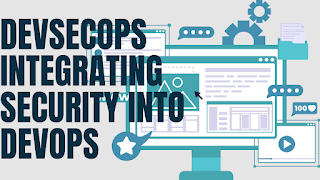📘 DevSecOps – Integrating Security into Every DevOps Stage
DevSecOps is one of the most searched and adopted strategies in DevOps for 2025. As security breaches and compliance demands rise, integrating security early and continuously across the development lifecycle is no longer optional. DevSecOps ensures that security is treated as a shared responsibility and embedded from code to production. This approach aligns with modern DevOps priorities: speed, collaboration, resilience, and trust.
📌 Why DevSecOps Is Essential in 2025
✔ Security incidents cause massive financial and reputational damage
✔ Cloud-native apps introduce complex attack surfaces
✔ Compliance requirements demand continuous evidence of controls
✔ Shift-left security improves vulnerability detection timing
✔ DevSecOps aligns development, operations, and security teams seamlessly
✅ Core Principles of DevSecOps
✔ Security is integrated from the first line of code
✔ Automation handles repetitive security testing tasks
✔ Developers are empowered to write secure code
✔ CI/CD pipelines include security gates and controls
✔ Monitoring tools detect and alert on real-time threats
✅ Benefits of Adopting DevSecOps Practices
✔ Prevents vulnerabilities from reaching production environments
✔ Reduces cost of fixing security issues by addressing them early
✔ Builds a culture of shared responsibility and awareness
✔ Automates compliance reporting and audit trails
✔ Enables faster, more secure software releases
✅ Key Components of a DevSecOps Workflow
✔ Secure Coding Practices
✔ Train developers on secure design and OWASP Top 10
✔ Use linters and static analysis tools during local development
✔ Enforce security-focused code review practices
✔ Include threat modeling during architectural design
✔ Validate input, manage secrets securely, and limit privileges
✔ Static and Dynamic Code Analysis
✔ Use SAST tools to scan code at every commit
✔ DAST tools test running applications for vulnerabilities
✔ Run scans automatically in CI pipelines
✔ Gate builds if critical vulnerabilities are detected
✔ Generate reports for compliance and tracking
✔ Dependency and Container Scanning
✔ Scan third-party libraries and open-source components
✔ Monitor for CVEs (Common Vulnerabilities and Exposures)
✔ Use tools like Trivy, Snyk, and Grype in CI/CD
✔ Scan Docker images and Kubernetes manifests before deployment
✔ Remove unused dependencies and minimize image sizes
✔ Infrastructure as Code (IaC) Security
✔ Scan Terraform, Ansible, CloudFormation, and Helm charts
✔ Detect misconfigurations like open ports or excessive privileges
✔ Validate against policy-as-code frameworks like OPA or Checkov
✔ Monitor drift between declared and live infrastructure
✔ Track all changes through Git commits and pull requests
✔ Secrets Management
✔ Avoid hardcoding API keys and credentials
✔ Store secrets in encrypted vaults like HashiCorp Vault or AWS Secrets Manager
✔ Inject secrets at runtime using secure mechanisms
✔ Rotate secrets automatically to limit exposure
✔ Audit access and use of all credentials across environments
✔ Continuous Monitoring and Runtime Protection
✔ Use tools like Falco, CrowdStrike, and Sysdig for runtime anomaly detection
✔ Log security events and user behavior in real time
✔ Monitor network traffic, file access, and system calls
✔ Alert on policy violations and suspicious activities
✔ Automatically isolate compromised containers or services
✅ DevSecOps in CI/CD Pipelines
✔ Embed security gates into GitHub Actions, GitLab CI, or Jenkins pipelines
✔ Break builds when high-severity issues are found
✔ Use pre-commit hooks for linting and formatting
✔ Schedule nightly scans of production codebases
✔ Visualize scan results in dashboards for team visibility
✅ DevSecOps in Kubernetes and Cloud Environments
✔ Use admission controllers to validate deployments
✔ Enforce Pod Security Policies and NetworkPolicies
✔ Encrypt secrets and storage at rest and in transit
✔ Configure IAM roles and policies with the principle of least privilege
✔ Implement container runtime protection and node scanning
✅ SEO-Optimized Keywords for This Article
✔ DevSecOps tools 2025
✔ DevOps security automation
✔ CI/CD pipeline security
✔ infrastructure as code scanning
✔ secrets management DevOps
✔ Kubernetes security best practices
✔ shift-left security
✅ Common DevSecOps Challenges
✔ Balancing speed and security in fast-moving teams
✔ Integrating tools without bloating pipelines
✔ Educating developers on security risks and responsibilities
✔ Managing false positives from automated tools
✔ Securing legacy systems and third-party dependencies
✅ Best Practices for Implementing DevSecOps
✔ Choose tools that integrate natively with your stack
✔ Build a security champion network inside dev teams
✔ Track security KPIs like MTTR for vulnerabilities
✔ Regularly review and update policies and configurations
✔ Foster a no-blame culture where security issues are addressed collaboratively
✅ Industries Driving DevSecOps Adoption
✔ Fintech and banking require continuous compliance evidence
✔ Healthcare systems must secure patient data under HIPAA
✔ E-commerce platforms are prime targets for data theft
✔ Government agencies enforce strict cybersecurity standards
✔ SaaS companies use DevSecOps to scale securely and gain trust
✅ Future of DevSecOps in Software Delivery
✔ AI-driven security insights will predict breach risks
✔ Security as code will be a default part of all CI pipelines
✔ Compliance automation will replace manual audits
✔ DevSecOps will be built into platform engineering and internal dev portals
✔ Cross-team collaboration on security will become a baseline expectation
🧠 Conclusion
DevSecOps is not just a trend—it’s the future of secure, scalable software development. By embedding security into every DevOps stage, organizations reduce risks, speed up delivery, and build trust with users. In 2025, the companies leading in DevOps maturity are those making DevSecOps a core part of their culture, tools, and strategy. Developers, operations, and security teams must move forward together to secure the software supply chain from start to finish.

